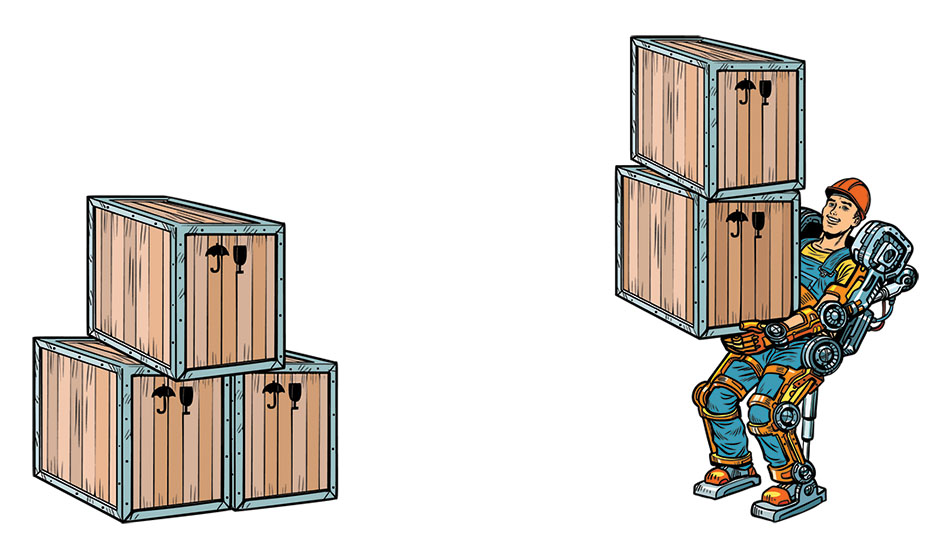 studiostoks / Shutterstock
studiostoks / Shutterstock
Exoskeletons have long been of interest in the medical sector. Scientists have worked for decades on creating more technologically advanced exoskeleton systems that have been used in medical rehabilitation. However, now it is time for a shift.
A number of exoskeleton suppliers have switched focus and are now heading to break into another market. They’re creating industrial exoskeletons, designed to support a range of tasks that would normally be done manually by a human worker, but require vast amounts of physical effort. These exoskeletons are already available commercially, and the industrial market has responded well, embracing the new technology that is causing a disruption.
Currently, some major industry players are running tests on these new industrial exoskeleton systems, as well as supporting the continued and rapid development of their applications. In addition, the standards and regulatory issues of industrial exoskeletons are not as complex as the standards and regulations for the use of exoskeletons in the medical industry.
These are all markers that indicate exoskeletons with industrial applications is a market that will grow strongly, and potentially be more lucrative than their applications in the medical space. What’s more encouraging is that the value proposition is straightforward and the return of interest is easily calculated for their industrial applications in comparison to their medical ones.
Industrial applications of exoskeletons are focused on assisting in tasks that are physically demanding for humans to complete and also haven’t been solved through innovations in traditional automated methods. They are also looking to transform tasks that can be repetitive for human workers. The technology is being viewed as a step between fully robotic tasks and fully manual, requiring human workers to complete the task unaided.
In all applications of industrial exoskeletons, the machinery is worn by the worker, but how the exoskeleton functions can vary depending on the task it is designed to do. Their current applications are discussed below.
Reducing Neck and Back Pressure
Testing is currently underway at the North American Hyundai-KIA factory testing the Hyundai Vest Exoskeleton (H-VEX), an exoskeleton that has been designed to reduce pressure on the necks and backs of workers. The aim of the exoskeleton is to reduce injuries as well as to increase worker efficiency in the automotive industry. Presumably, it will be used for workers who are involved in intense manual labor.
Performing Overhead Tasks
Last year, Ford hit the headlines with announcements that it was incorporating 75 exoskeletons from Ekso Bionic into its production processes. These exoskeletons were upper-body exoskeletons, designed to help workers complete overhead tasks, taking the weight and strain off the workers with an aim to reduce workplace injury. The exoskeletons have been added to 15 worldwide locations.
Repetitive Arm Motions
The AIRFRAME exoskeleton has been developed by Levitate Technologies in order to assist workers in completing tasks that rely on repetitive arm motions. BMW is one large company that is currently trialing the system in a number of its plants. It is estimated that the exoskeleton can reduce worker exertion by up to 80%.
Lifting and Moving Heavy Objects
Home improvement retailer, Lower, announced back in 2017 that their innovation lab had begun to trial the use of unpowered exoskeletons. The exoskeletons, which were designed by Lowe and Virginia Tech’s Assistive Robotics Laboratory (ARL), are being used at Lowe to help their stocking staff lift and move heavy objects. This kind of exoskeleton has the potential to be used in all kinds of warehouses, where workers are repeatedly moving around the heavy stock.
Applications of industrial exoskeletons are in their infancy, with development only recently switching focus from the medical sector. However, given its numerous benefits, we can expect the market to rapidly increase, alongside new technology and applications. What’s also expected to help with this is the anticipated advances in enabling technologies, such as batteries and materials.
Source
Disclaimer: The views expressed here are those of the author expressed in their private capacity and do not necessarily represent the views of AZoM.com Limited T/A AZoNetwork the owner and operator of this website. This disclaimer forms part of the Terms and conditions of use of this website.